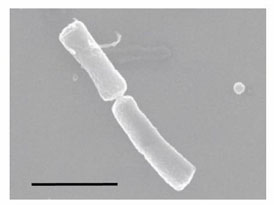The sequencing of Pyrobaculum calidifontis will greatly assist in future microbiology investigations of the genus because it is able to grow both aerobically and anaerobically on simple organic media to high cell densities. Moreover, Pyrobaculum calidifontis can be plated under aerobic conditions. These characteristics will facilitate genetic, biochemical, and microbiological studies and encourage diverse investigators without requiring extensive experience with extremophiles. The comparative genomics of P. calidifontis and other Pyrobaculum species will be informative because some metabolic characteristics of P. calidifontis (ie growth under atmospheric O2 concentrations) are unique thus far among described members of the genus while other characteristics (ie sulfur toxicity) are shared with other species within the genus. Relevant Literature References: Yamada T, Fujii T, Kanai T, Amo T, Imanaka T, Nishimasu H, Wakagi T, Shoun H, Kamekura M, Kamagata Y, Kato T, Kawashima K., Expression of acetylcholine (ACh) and ACh-synthesizing activity in Archaea., Life Sci. 2005 Sep 2;77(16):1935-44. Amo T, Atomi H, Imanaka T., Biochemical properties and regulated gene expression of the superoxide dismutase from the facultatively aerobic hyperthermophile Pyrobaculum calidifontis., J Bacteriol. 2003 Nov;185(21):6340-7. Hotta Y, Ezaki S, Atomi H, Imanaka T., Extremely stable and versatile carboxylesterase from a hyperthermophilic archaeon., Appl Environ Microbiol. 2002 Aug;68(8):3925-31. Amo T, Atomi H, Imanaka T., Unique presence of a manganese catalase in a hyperthermophilic archaeon, Pyrobaculum calidifontis VA1., J Bacteriol. 2002 Jun;184(12):3305-12. Amo T, Paje ML, Inagaki A, Ezaki S, Atomi H, Imanaka T., Pyrobaculum calidifontis sp. nov., a novel hyperthermophilic archaeon that grows in atmospheric air., Archaea. 2002 Sep;1(2):113-21. |
||
|
||
Pyrobaculum calidifontis

 Photo credit: T. Amo et al, Archaea 2002. Bar=1um (micron).
Photo credit: T. Amo et al, Archaea 2002. Bar=1um (micron).